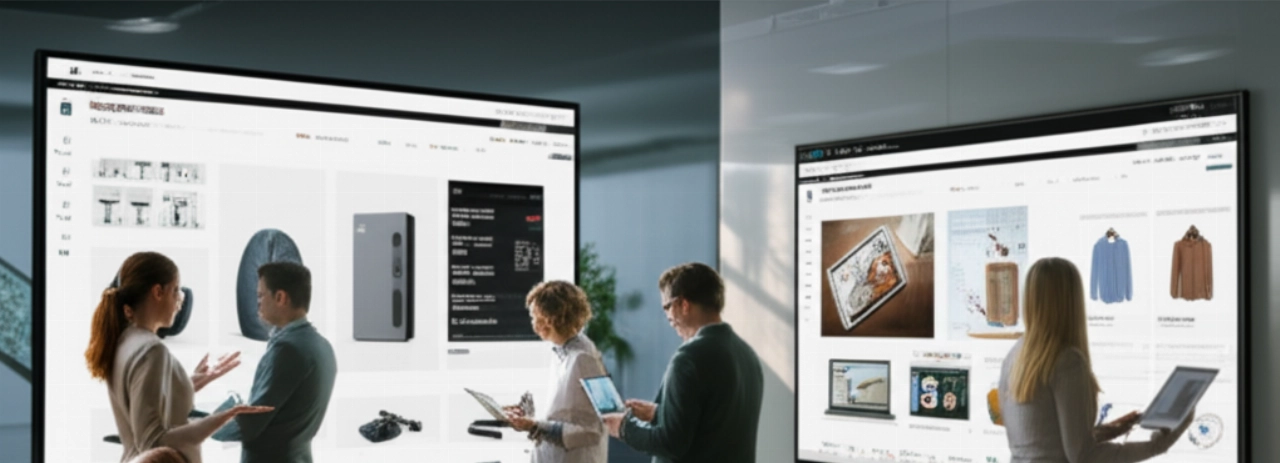In the high-stakes world of B2B and enterprise e-commerce, the phrase "CRM ecommerce integration cost" often triggers a mix of trepidation and strategic necessity. It’s not just about connecting two systems; it’s about forging the central nervous system of your digital operations. For many E-commerce VPs, CTOs, and CEOs, the current reality is a fragmented landscape: customer data trapped in silos, sales teams operating blind, and marketing efforts missing their mark due to a lack of a unified customer view. This isn't just inefficient; it's a direct threat to your competitive edge and your ability to scale.
You’re not alone if you've felt the pain of manual data transfers, the frustration of inconsistent customer experiences, or the dread of a scalability ceiling looming over your current setup. The truth is, without a seamless, intelligent connection between your Customer Relationship Management (CRM) system and your e-commerce platform, you're leaving significant revenue on the table and incurring hidden operational costs that far outweigh any initial integration investment. This article isn't about a simple price tag; it's your definitive guide to transforming the crm ecommerce integration cost from a perceived expense into the most strategic investment you'll make this decade, engineering a unified commerce ecosystem that drives exponential growth.

Beyond the Transaction: Why Your CRM-Ecommerce Integration is Your Next Growth Engine
Think beyond mere data synchronization. A truly integrated CRM and e-commerce platform isn't just about moving information; it's about creating a living, breathing intelligence hub that understands, predicts, and responds to every customer interaction. This is where your customer journey mapping becomes actionable, where personalization moves from a buzzword to a powerful revenue driver, and where your sales and marketing teams finally operate with a single source of truth.
- Hyper-Personalization at Scale: Imagine tailoring product recommendations, pricing, and content based on a customer's entire purchase history, browsing behavior, and communication preferences, all managed seamlessly through your CRM. This isn't possible with disconnected systems.
- Streamlined Sales & Service: Empower your sales team with real-time insights into customer orders, inquiries, and service tickets directly from the CRM. Reduce friction, accelerate sales cycles, and deliver proactive support that builds loyalty.
- Optimized Marketing Campaigns: Segment your audience with precision, launch targeted campaigns, and track ROI with unprecedented accuracy. Your marketing efforts become more efficient and effective, directly impacting your conversion rate optimization (CRO).
- Operational Efficiency & Reduced TCO: Eliminate manual data entry, reduce errors, and automate workflows. This not only frees up valuable resources but significantly lowers your total cost of ownership (TCO) by minimizing operational overhead and the need for costly workarounds.
This strategic synergy is the foundation of a robust, future-proof digital commerce strategy. It's the difference between merely selling online and truly owning your market.

Deconstructing the CRM Ecommerce Integration Cost: A Strategic Investment, Not a Line Item
Understanding the crm ecommerce integration cost requires a shift in perspective. It's not a singular number but a composite of strategic investments, each contributing to a higher ROI. Here’s a breakdown of the key components:
1. Discovery & Strategy Phase:
- Business Process Analysis: Deep dive into your current workflows, identifying bottlenecks and opportunities for automation.
- Requirements Gathering: Defining precise functional and non-functional requirements for the integration.
- Solution Architecture Design: Crafting the blueprint for how your CRM, e-commerce, ERP integration, and other systems will communicate. This is where the foundation for a composable commerce approach is laid.
2. Platform & Licensing Fees:
- CRM Software: Annual or monthly fees for your chosen CRM (e.g., Salesforce, HubSpot, Microsoft Dynamics).
- E-commerce Platform: Licensing for your enterprise platform (e.g., Adobe Commerce/Magento, Shopify Plus, BigCommerce Enterprise).
- Integration Platform as a Service (iPaaS): Tools like MuleSoft, Dell Boomi, or custom API-first solutions that facilitate seamless data flow.
3. Development & Customization:
- API Development: Building custom APIs or configuring existing ones to ensure robust data exchange.
- Data Mapping & Transformation: Ensuring data consistency and integrity between systems. This is critical for avoiding data chaos.
- Workflow Automation: Developing custom logic to automate processes like order synchronization, customer updates, and inventory management.
- UI/UX Adjustments: Ensuring the front-end experience reflects the integrated back-end capabilities.
4. Data Migration & Cleansing:
- Historical Data Transfer: Moving existing customer, order, and product data from legacy systems to the new integrated environment.
- Data Cleansing: Crucial for ensuring the accuracy and usability of migrated data, preventing the propagation of errors.
5. Testing & Quality Assurance:
- Integration Testing: Verifying that all connected systems communicate correctly.
- User Acceptance Testing (UAT): Ensuring the solution meets your business needs and user expectations.
- Performance Testing: Validating the system's ability to handle peak loads without performance bottlenecks.
6. Training & Change Management:
- User Training: Equipping your teams to leverage the new integrated system effectively.
- Documentation: Providing comprehensive guides for ongoing maintenance and troubleshooting.
7. Post-Launch Support & Maintenance:
- Monitoring & Optimization: Continuous oversight to ensure peak performance and identify areas for improvement.
- Updates & Upgrades: Keeping systems current with the latest features and security patches.
Each of these components contributes to the overall crm ecommerce integration cost, but more importantly, each is an investment in reducing future operational expenses, improving customer satisfaction, and unlocking new revenue streams. The true cost isn't what you pay upfront, but the ROI you generate over time.

The Hidden Costs of Disconnected Systems: Why 'Cheap' Integration is the Most Expensive Mistake
Many enterprises fall into the "one-size-fits-all" trap or opt for seemingly cheaper, off-the-shelf solutions that promise quick fixes. The reality is, these often lead to a different kind of cost – the hidden, insidious expenses of a fragmented digital landscape. This is where the fear of a failed migration or the dread of integration hell becomes a daily reality.
- Manual Data Entry & Errors: Relying on human intervention to transfer data between CRM and e-commerce leads to significant time waste, increased labor costs, and a high probability of costly errors. Inconsistent data synchronization cripples decision-making.
- Poor Customer Experience: Disconnected systems mean your customer service agents lack a complete view of customer interactions, leading to frustrating, disjointed experiences. This directly impacts customer retention and lifetime value.
- Ineffective Marketing & Sales: Without unified data, personalization is impossible, marketing campaigns are generic, and sales teams miss critical opportunities. Your conversion rates suffer, and your competitive advantage erodes.
- Scalability Ceiling: As your business grows, manual processes and rigid, unintegrated systems buckle under the pressure. You hit a performance bottleneck, unable to handle increased traffic, orders, or product complexity.
- Lost Revenue Opportunities: Inability to cross-sell, upsell, or recover abandoned carts effectively due to lack of real-time, unified customer insights.
- Technical Debt Accumulation: Patchwork solutions and quick fixes create a mountain of technical debt, making future upgrades, new feature implementations, and even simple maintenance exponentially more complex and expensive.
The "cheap" option often means you're paying for a solution that doesn't truly solve your problems, but merely postpones them, leading to a much higher total cost of ownership in the long run. It's a false economy that stifles growth and innovation.
Case Study: Unifying Customer Data for a Global B2B Distributor – 30% Boost in LTV
A leading global B2B distributor, managing thousands of SKUs and complex pricing structures, faced a critical challenge: their legacy e-commerce platform and CRM were completely disconnected. Sales representatives spent hours manually updating customer records, order histories were fragmented, and marketing efforts were generic. They were hitting a scalability ceiling, unable to personalize experiences for their diverse client base.
Commerce K partnered with them to architect a comprehensive CRM-ecommerce integration. We implemented an API-first approach, connecting their enterprise CRM with a robust, custom-built e-commerce platform. This involved meticulous data mapping, custom workflow automation for order processing and customer segmentation, and a focus on real-time data synchronization.
The Results:
- 30% increase in Customer Lifetime Value (LTV) within 18 months due to hyper-personalized product recommendations and targeted promotions.
- Reduced manual data entry by 70%, freeing up sales and customer service teams to focus on strategic initiatives.
- Improved order accuracy by 95%, virtually eliminating costly shipping errors and customer complaints.
- Enhanced customer satisfaction scores due to a seamless, unified experience across all touchpoints.
This wasn't just an integration; it was a strategic transformation that unlocked significant growth and solidified their market position.
Engineering Your Unified Future: The Commerce K Approach to CRM-Ecommerce Synergy
At Commerce K, we understand that the crm ecommerce integration cost is not merely a project expense; it's an investment in your enterprise's future. We don't just connect systems; we engineer unified commerce ecosystems designed for unparalleled scalability, performance, and strategic advantage. Our approach is rooted in the principles of composable commerce and MACH architecture, ensuring your solution is not only powerful today but future-proof for tomorrow.
We act as your strategic technology partner, guiding you through every phase from initial discovery to post-launch optimization. Our expertise spans complex B2B workflows, multi-system integrations (including PIM integration, ERP, WMS), and crafting bespoke solutions that transcend the limitations of off-the-shelf platforms. We focus on delivering a lower total cost of ownership by building robust, efficient, and adaptable architectures that minimize technical debt and maximize ROI.
With Commerce K, you gain a partner who understands the nuances of enterprise-level complexity, the critical importance of data integrity, and the strategic value of a truly unified customer view. We transform your integration challenges into opportunities for competitive differentiation and sustained growth.
Frequently Asked Questions about CRM Ecommerce Integration Cost
Here are some common questions enterprise leaders ask about the investment in CRM-ecommerce integration:
Q: What is the typical ROI for a comprehensive CRM-ecommerce integration?
A: While specific ROI varies by industry and business model, our clients typically see significant returns through increased customer lifetime value, improved operational efficiency, reduced manual labor costs, and enhanced conversion rates. Many achieve full ROI within 18-36 months, with ongoing benefits far exceeding the initial investment. We focus on measurable outcomes like increased sales, reduced churn, and optimized marketing spend.
Q: How long does a complex CRM-ecommerce integration project usually take?
A: The timeline depends heavily on the complexity of your existing systems, the volume of data, and the level of customization required. A comprehensive enterprise-level integration can range from 6 to 18 months. Our detailed discovery phase provides a precise roadmap and timeline, ensuring transparency and managing expectations from the outset.
Q: What are the biggest risks associated with a CRM-ecommerce integration, and how does Commerce K mitigate them?
A: Key risks include data corruption, system downtime, scope creep, and user adoption challenges. We mitigate these through rigorous planning, meticulous data migration strategies, phased rollouts, comprehensive testing (including UAT), and robust change management programs. Our API-first approach ensures minimal disruption and maximum flexibility, and our experienced team anticipates and addresses potential pitfalls proactively.
Q: Is a custom integration always necessary, or can we use off-the-shelf connectors?
A: While off-the-shelf connectors can be suitable for simpler needs, enterprise-level businesses often require custom integration to support unique business logic, complex pricing models, specific B2B workflows, or high-volume data synchronization. We assess your specific requirements during the discovery phase to recommend the most appropriate and cost-effective approach, often leveraging a hybrid model that combines robust platforms with bespoke API development for critical functionalities.
Q: How does this integration impact our existing ERP and other business systems?
A: A well-executed CRM-ecommerce integration often serves as a central hub, enhancing data flow to and from your ERP, WMS, PIM, and other critical systems. We design solutions that ensure seamless data synchronization across your entire technology stack, creating a truly unified commerce ecosystem. Our goal is to eliminate data silos and provide a single source of truth for all business operations.
You've navigated the complexities of enterprise commerce long enough. It's time to stop treating your CRM and e-commerce platforms as separate entities and start engineering them as a unified, intelligent ecosystem. The journey from technical confusion to strategic clarity begins with understanding that the crm ecommerce integration cost is not an expenditure, but a catalyst for unprecedented growth and operational excellence.
Don't let the fear of a failed project or the perceived complexity deter you. Your business deserves a clear digital commerce roadmap that delivers measurable results and a competitive moat. The first step isn't a quote; it's a no-obligation Scoping & Strategy Session with our senior architects. We'll help you map your potential, de-risk your investment, and uncover the opportunities you're currently missing by operating in silos. Click here, tell us about your project, and discover how a truly unified commerce ecosystem can transform your business. Start building your future-proof commerce engine today.
Now that you understand the strategic value of CRM-ecommerce integration, explore how we execute a seamless ecommerce migration service or discover the power of headless commerce agency solutions for ultimate flexibility.





